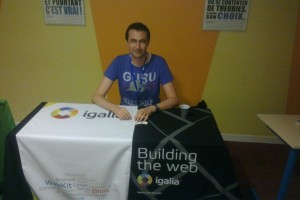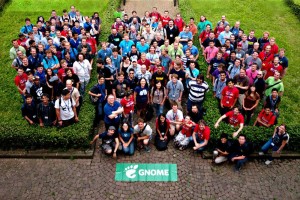GUADEC 2014
The last Friday 25 of July, National Day of Galicia, started very early because I had to travel to Strasbourg, official seat of the European Parliament, not for any political duty, but for the GNOME Users and Developers European Conference, the GUADEC!My last GUADEC was in The Hague, in 2010, though in 2012, when it was hosted in Coruña, I attended a couple talks. Nonetheless, it had been a long time since I met the community, and it was a pleasure to me meet them again.
My biggest impression was the number of attendees. I remember the times in Turkey or in Gran Canaria where hundreds packed the auditoriums and halls. Nowadays the audience was smaller, but that is a good thing, since now you get in touch with the core of developers who drive and move the project easily.
We, Igalia, as sponsors, had a banner in the main room and a table in a corridor. Here is a picture of Juan to prove it:

Also I ran across with Emmanuele Bassi, setting up a booth to show up the Endless Mobile OS, based on GNOME 3. The people at GUADEC welcomed with enthusiasm the user experience provided by it and the purpose of the project. Personally, I love it. If you don’t know the project, you should visit their web site.
The first talk I attended what the classic GStreamer update by Sebastian Dröge and Tim Müller. They talked about the new features in GStreamer 1.4. Neat stuff in there. I like the new pace of GStreamer, rather of the old stagnated evolution of 0.10 version.
Afterwards, Jim Hall gave us a keynote about Usability in GNOME. I really enjoyed that talk. He studied the usability of several GNOME applications such as Nautilus (aka Files), GEdit, Epiphany (aka Web), etc., as part of his Masters’ research. It was a pleasure to hear that Epiphany is regarded as having a good usability.
After lunch I was in the main room hearing Sylvain Le Bon about sustainable business models for free software. He talked about crowd funding, community management and related stuff.
The next talk was Christian Hergert about his project GOM, an object mapper from GObjects to SQLite, which is used in Grilo to prevent SQL injection by some plugins that use SQLite.
Later on, Marina Zhurakhinskaya gave us one of the best talks of the GUADEC: How to be an ally to women in tech. I encourage you to download the slides and read them. There I learned about the unicorn law and the impostor syndrome.
The day closed with the GNOME Foundation’s teams reports.
Sunday came and I arrived to the venue for the second keynote: Should We Teach The Robot To Kill by Nathan Willis. In his particular style, Nathan, presented a general survey of GNU/Linux in the Automotive Industry.
Next, one of main talks from Igalia: Web 3.12: a browser to make us proud, presented by Edu. It was fairly good. Edu showed us the latest development in WebKitGTK+ and Epiphany (aka Web). There were quite a few questions at the end of the talk. Epiphany nowadays is actively used by a lot of people in the community.
After, Zeeshan presented his GNOME boxes, an user interface for running virtual machines. Later on Alberto Ruiz showed us Fleet Commander, a web application to handle large desktop deployments.
And we took our classic group photo:

That Sunday closed with the intern’s lighting talks. Cool stuff is being cooked by them.
On Monday I was in the venue when Emmanuele Bassi talked us about GSK, the GTK+ Scene Graph Kit, his new project, using as a starting point the lessons learned in Clutter. Its objective is to have a scene graph library fully integrated in GTK+.
After the lunch and the second part of the Foundation’s Annual General Meeting, Benjamin Otte gave an amusing talk about the CSS implementation in GTK+. Later, Jasper St. Pierre talked about the Wayland support in GNOME.
When the coffee break ended, the almighty Žan Doberšek gave the other talk from Igalia: Wayland support in WebKit2GTK+.
In the last day of the GUADEC, I attended Bastien Nocera’s talk: Hardware integration, the GNOME way, where he reviewed the history of his contributions to GNOME related with hardware integration and the goal of nicely support most of the hardware in GNOME, like compasses, gyroscopes, et cetera.
Afterwards, Owen Taylor talked us about the GNOME’s continuous integration performance testing, in order to know exactly why one release of GNOME is faster or slower than the last.
And the third keynote came: Matthew Garrett talked us about his experiences with the GNOME community and his vision about where it should go: to enhance the privacy and security of the users, something that many GNOMErs are excited about, such as Federico Mena.
Later on, David King talked about his plans for Cheese, the webcam application, turning it into a DBus service, using the current development of kdbus to sandbox the interaction with the hardware.
Afterwards Christian Hergert talked us about his plans for Builder, a new IDE for GNOME. Promising stuff, but we will see how it goes. Christian said that he is going to take a full year working on this project.
The GUADEC ended with the lighting talks, where I enjoyed one about the problems around the current encryption and security tools.
Finally, the next GUADEC host was unveiled: the Sweden Conspiracy: Gothenburg!
- Previous: See you at GUADEC!
- Next: GStreamer Hackfest 2015